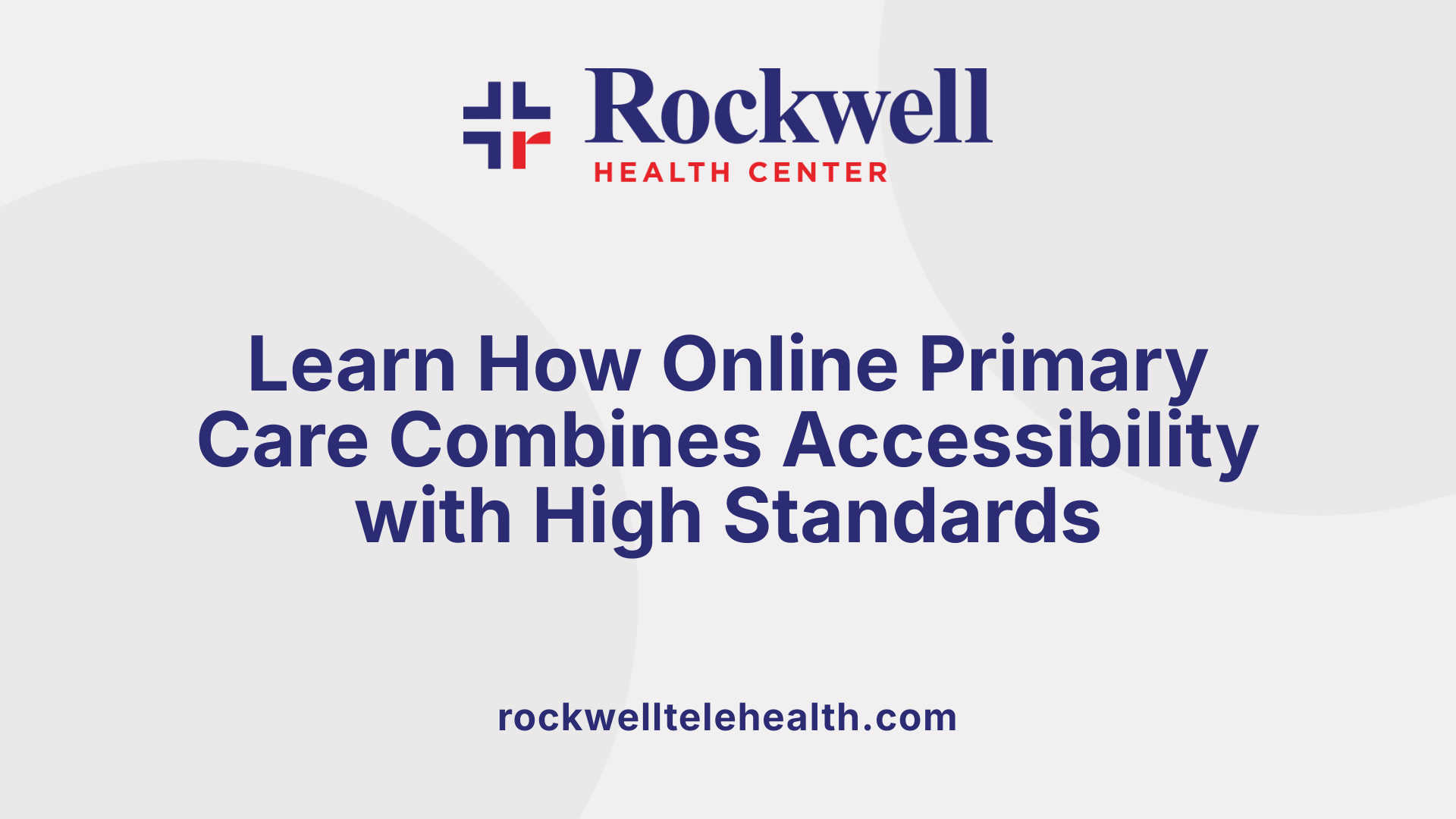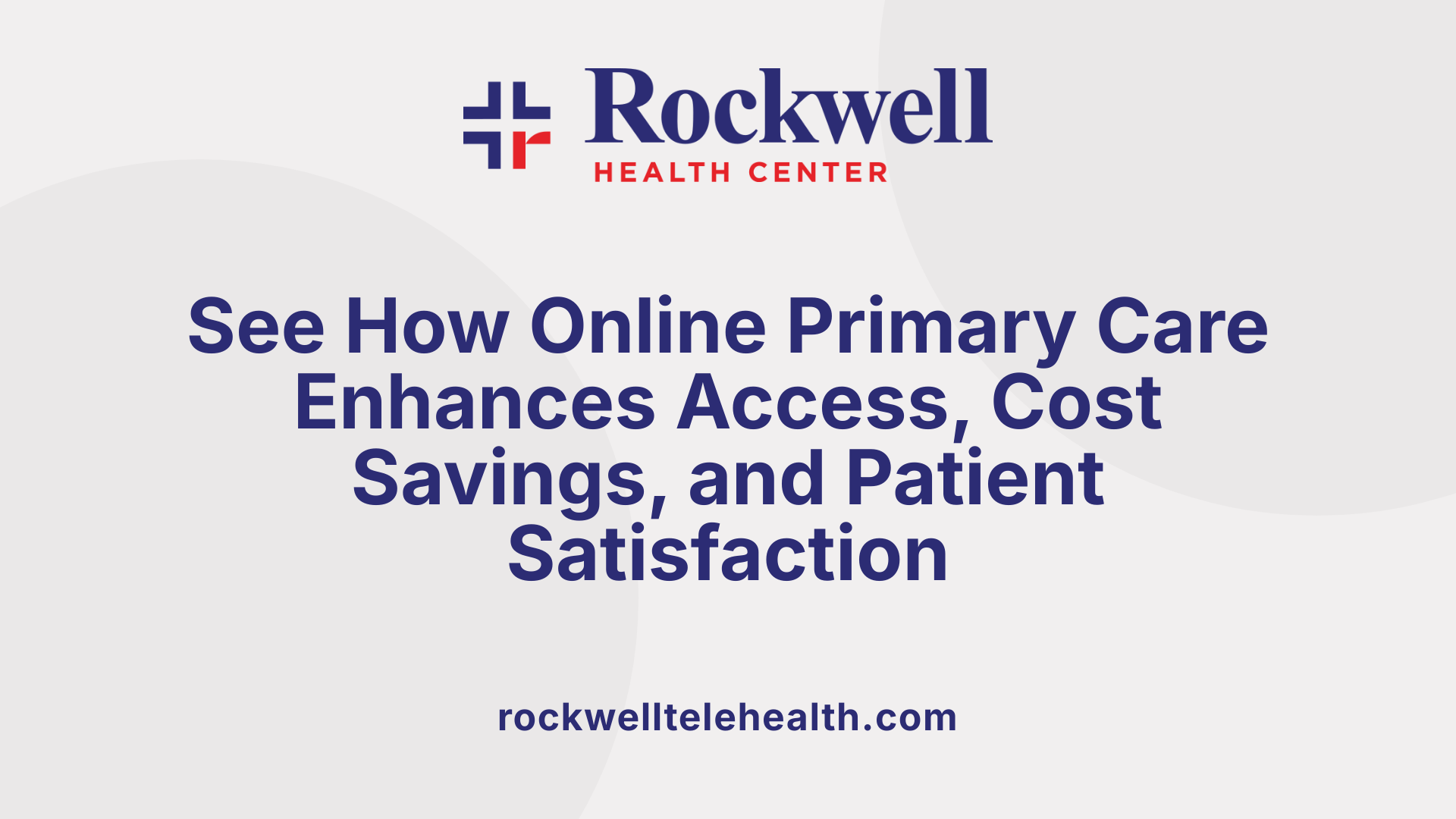Revolutionizing Primary Care with Virtual Services
The evolution of primary care through online platforms has significantly enhanced how patients access high-quality healthcare. By leveraging telehealth technologies such as video consultations, digital communication, and remote monitoring, these services offer unparalleled convenience and comprehensive care. This article explores the expanding landscape of virtual primary care, its operational models, benefits, and how it effectively meets diverse patient needs.
Understanding Online Primary Care Services: Bridging Convenience and Quality

What are online primary care services, and how do they combine convenience and quality?
Online primary care services are healthcare offerings delivered through digital platforms, allowing patients to connect with healthcare providers via video, phone, or secure messaging. These services cover a broad spectrum, including routine check-ups, management of chronic conditions like high blood pressure, mental health support such as counseling, and urgent care for minor injuries or illnesses.
By utilizing telehealth technologies, these services eliminate the need for physical visits, providing a more accessible and flexible option—especially beneficial for those in remote areas, with mobility issues, or with busy schedules.
Services like Mass General Brigham Virtual Urgent Care, Doctor On Demand, and Included Health exemplify how virtual platforms make medical care more convenient. Patients can create accounts, schedule visits online, and meet with licensed healthcare professionals without leaving home. This approach not only saves time but also enhances continuity of care by enabling ongoing relationships with providers.
Further, these platforms often include features such as prescription refills, follow-up communications, and access to visit summaries through patient portals like Patient Gateway. This integrated digital communication fosters better health management, timely intervention, and disease prevention, thereby blending the ease of remote access with high-quality, comprehensive care.
Overall, online primary care services deliver targeted, efficient, and personalized healthcare, overcoming many barriers of traditional in-person visits while maintaining high standards of medical quality.
How Virtual Care Works and Its Advantages

How do virtual care options work, and what are their benefits?
Virtual care services operate by harnessing digital communication technologies to connect patients with healthcare providers without the need for in-person visits. Patients can schedule appointments online through their devices or phones, choosing from a variety of services such as urgent care, primary care, mental health support, or specialist consultations.
Once scheduled, patients meet with licensed healthcare professionals via secure video calls, phone conversations, or messaging platforms. During these virtual visits, providers can perform assessments, diagnose conditions, prescribe medications, and give health advice. Some platforms also enable remote monitoring using devices that track vital signs or other health indicators.
This approach simplifies access to healthcare, especially for those living in remote or underserved areas or with limited mobility. It minimizes wait times, reduces the need for travel, and offers flexible scheduling options that fit into busy lifestyles. For example, organizations like Mass General Brigham provide virtual urgent care for minor injuries and conditions, available 7 days a week from early morning until late evening.
The benefits extend beyond convenience. Virtual care helps prevent the spread of infectious diseases by reducing in-person contact, which was especially important during the COVID-19 pandemic. It also allows for more continuous management of chronic diseases like high blood pressure or diabetes through regular virtual check-ins. Moreover, mental health services via platforms like Well Connection provide accessible support for depression, anxiety, and emotional trauma, often with very short wait times.
While virtual care offers numerous advantages, it is important to note that it is not suitable for emergencies or complex health issues requiring physical examinations or urgent interventions. In such cases, traditional in-person care or calling 911 remains essential.
Overall, virtual healthcare is transforming the way we access and manage health, blending convenience with quality care delivery to meet diverse patient needs.
Diving Into Telehealth: Types, Operations, and Service Range

What is telehealth, what types of services does it include, and how does it operate?
Telehealth represents a modern approach to healthcare delivery that leverages digital communication technologies to provide medical services remotely. It encompasses various methods of connecting patients with healthcare providers without requiring in-person visits, making healthcare more accessible and convenient.
There are three primary modes of telehealth:
Synchronous Telehealth: This involves real-time, live interactions between patients and providers. Examples include video calls or phone consultations where medical advice, diagnosis, and treatment planning occur instantly.
Asynchronous Telehealth: Also known as store-and-forward, this method transmits health data, images, or reports collected from patients to providers for later review. Patients can send symptoms or medical information through secure platforms, and providers assess and respond when convenient.
Remote Monitoring: Using specialized devices, patients' vital signs and health metrics are continuously collected and transmitted to healthcare professionals. This approach is especially useful for managing chronic conditions, such as hypertension or diabetes, providing ongoing oversight without frequent office visits.
Operationally, telehealth relies on secure, encrypted platforms that ensure patient privacy and comply with health data regulations like HIPAA. These platforms facilitate seamless communication between patients and providers through various devices, including smartphones, tablets, and computers.
Reimbursement policies for telehealth services vary, influenced by federal and state laws, insurance plans, and healthcare providers. Some services are fully covered, particularly during situations like the COVID-19 pandemic, while others may have co-pays or limitations depending on insurance benefits.
The main aim of telehealth is to make healthcare more accessible, particularly for individuals in rural or underserved areas, reduce healthcare costs, and improve patient outcomes through better care coordination.
Typical offerings include virtual visits for primary and specialty care, remote health monitoring for chronic disease management, online health education, and follow-up consultations. Platforms like Mass General Brigham, Doctor On Demand, and Blue Cross Blue Shield’s Well Connection exemplify how diverse and expansive telehealth services have become.
| Type of Telehealth | Description | Typical Use Cases | Advantages |
|---|---|---|---|
| Synchronous | Live, real-time interactions | Urgent care, mental health support, routine checkups | Immediate feedback, personal connection |
| Asynchronous | Store-and-forward data sharing | Skin condition assessments, pre-surgical consultations | Flexible timing, efficient review |
| Remote Monitoring | Continuous health data collection | Chronic disease management, postoperative monitoring | Ongoing oversight, early detection of issues |
With the development of telehealth services, healthcare delivery continues to evolve toward more flexible, patient-centered care models that blend virtual and in-person interactions for optimal health outcomes.
Membership Plans: Access and Advantages in Virtual Healthcare

What are membership plans for virtual healthcare, and how do they provide access to online primary care?
Membership plans for virtual healthcare are designed to offer patients broad and often unlimited access to various medical services through digital platforms. These plans typically include primary care, behavioral health, urgent care, and even specialty consultations, all covered under a fixed or predictable fee structure.
One of the main benefits of these memberships is the convenience they provide. Patients can connect with licensed healthcare providers through their smartphones or computers no matter where they are across the country. This makes seeking medical advice quicker and easier, especially for those with busy schedules or limited access to in-person clinics.
Many of these plans, such as Virtual Blue by UnitedHealthcare, eliminate the hassle of referrals for specialty care and include services like mental health counseling and chronic disease management. Patients can often select their preferred virtual doctors or continue seeing their existing in-person providers, fostering continuity of care.
Cost structure is another attractive aspect. These plans frequently feature low or waived copays for virtual visits, which helps control healthcare expenses and eliminates surprise bills. As a result, patients receive ongoing, accessible, and predictable healthcare that suits their lifestyle.
Overall, virtual healthcare membership plans are reshaping how individuals access medical services. They offer a flexible, efficient, and patient-centered approach to managing health, making quality care more accessible and easier to maintain long-term.
Benefits and Impact of Online Primary Care Services

What are the main benefits of using online primary care services?
Online primary care services bring significant advantages to patients and healthcare providers alike. One of the most notable benefits is the improved access to healthcare, especially for individuals living in remote, rural, or underserved areas. These services eliminate the need for long-distance travel, making it easier for patients with mobility challenges or limited transportation options to receive medical attention from the comfort of their homes.
Convenience is a core feature of virtual healthcare. Patients can schedule appointments easily via devices like phones or computers, often with same-day or next-day availability. Prescription refills, follow-up consultations, and health management can be handled efficiently, reducing waiting times and streamlining care processes.
The quality of care is maintained through the use of advanced technology, including remote monitoring devices and access to specialists for second opinions without requiring in-person visits. These tools support early diagnosis and better management of chronic conditions, promoting continuous engagement between patients and their healthcare teams.
Cost savings are another important aspect. Virtual care can lower expenses associated with transportation, time off work, and in some cases, reduce overall healthcare costs by preventing the need for emergency visits or hospital admissions. Insurers often cover many virtual visits, making healthcare more affordable for many patients.
Furthermore, virtual primary care enhances patient satisfaction by offering flexible, accessible, and personalized service. It encourages preventive health measures through regular check-ins and health education, fostering a proactive approach to wellness.
The impact of these services extends beyond individual health. By enabling ongoing management of health issues and improving access, virtual primary care contributes to a more equitable healthcare system, ensuring that more people receive timely and appropriate care. This integrated approach supports healthier communities overall.
| Benefit | Description | Additional Details |
|---|---|---|
| Increased accessibility | Reaches patients in remote or underserved areas | Especially helpful for mobility-challenged populations |
| Convenience | Easy scheduling and quick access to care | Virtual visits can be done from home at any time within operating hours |
| Continuity of care | Ongoing management of chronic conditions | Facilitates regular follow-up and monitoring |
| Cost effectiveness | Reduces travel and facility costs | Often covered by insurance and employer programs |
| Quality of care | Access to licensed healthcare providers | Includes remote diagnosis, treatment, and expert opinions |
| Patient satisfaction | Greater engagement and personalized service | Supports preventive and early intervention measures |
Overall, online primary care services are transforming healthcare delivery by making it more accessible, efficient, and patient-centered. They are an essential element in modern healthcare systems, especially in overcoming barriers faced by vulnerable populations, and contribute to a healthier society.
Advancing Healthcare with Digital Innovation
The proliferation of online primary care services is revolutionizing how patients access and experience healthcare. These virtual platforms seamlessly blend convenience with high-quality, comprehensive care, breaking down traditional barriers related to geography, mobility, and time constraints. As technology continues to evolve, so too will the capabilities of virtual care—integrating behavioral health, chronic disease management, and personalized medicine into increasingly user-friendly platforms. The future of primary care lies in harnessing innovations that improve health outcomes, enhance patient experience, and make healthcare more equitable and accessible for all.
References
- Virtual Care & Telehealth Appointments
- Doctor On Demand® Telehealth: 24-Hour Online Doctor
- Virtual Urgent Care
- Virtual primary care
- Online doctor visit with Well Connection
- Included Health - Healthcare Navigation & Virtual Care
- Virtual Care & Telemedicine Services
- Virtual Primary Care
- Telemedicine for healthcare: Capabilities, features, barriers ...
- Virtual Primary Care—Improving Access, Efficiency, and ...
























































































.png)